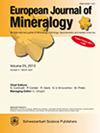Tomsquarryite, NaMgAl3(PO4)2(OH)6 ● 8H2O, a new crandallite-derivative mineral from Tom's phosphate quarry, Kapunda, South Australia
IF 1.7
3区 地球科学
Q2 MINERALOGY
引用次数: 1
Abstract
Abstract. Tomsquarryite, NaMgAl3(PO4)2(OH)6 ⚫ 8H2O, is a new secondary phosphate mineral from Tom's phosphate quarry, Kapunda, South Australia. It occurs as colourless, talc-like hexagonal platelets, with diameters of a few tens of micrometres when formed from the decomposition of minyulite and as thicker (∼ 10 µm) hexagonal crystals when formed from alteration of gordonite. Associated minerals are penriceite, elliottite, minyulite, angastonite and wavellite. The calculated density is 2.22 g cm−3. Tomsquarryite crystals are uniaxial (+) with ω=1.490(3), ε=1.497(3) (white light). Dispersion was not observed. The partial orientation is Z≈c. Electron microprobe analyses of the holotype specimen give the empirical formula Na1.02K0.02Ca0.08Mg1.26Al2.86(PO4)2.00(OH)3.82F2.48 ⚫ 7.70H2O, based on 22 anions. Tomsquarryite belongs to the trigonal crystal system, space group R–3m, with hexagonal unit-cell parameters a=6.9865(5) Å, c=30.634(3) Å and V=1294.9(4) Å3 and with Z=3. The crystal structure was refined using single-crystal diffraction data; R1=0.069 for 303 reflections with I>2σ(I) to a resolution of 0.80 Å. The crystal structure is a derivative of the crandallite structure, with Ca2+ cations replaced by hydrated magnesium ions, [Mg(H2O)6]2+, resulting in an expansion of the interlayer separation from 5.4 Å in crandallite to 10.2 Å in tomsquarryite. The results for tomsquarryite are compared with those for the chemically and structurally related minerals penriceite and elliottite.Tomsquarryite, NaMgAl3(PO4)2(OH)6●8H2O,一种新的辉长石衍生矿物,产自南澳大利亚Kapunda Tom's磷矿场
摘要Tomsquarryite (NaMgAl3(PO4)2(OH)6⚫8H2O)是一种新的次生磷矿,产自南澳大利亚Kapunda Tom磷矿场。它以无色的、滑石样的六角形片状物的形式出现,直径为几十微米,当由镁铝榴石分解形成时,直径为几十微米,当由高锰矿蚀变形成时,直径为更厚(~ 10微米)的六角形晶体。伴生矿物有辉石岩、辉石岩、微白云石、硅灰石和小波石。计算密度为2.22 g cm−3。Tomsquarryite晶体为单轴(+),ω=1.490(3), ε=1.497(3)(白光)。未观察到弥散。偏取向为Z≈c。基于22个阴离子,对样品进行电子探针分析得到经验式:an1.02 k0.02 ca0.08 mg1.26 al2.86 (PO4)2.00(OH)3.82F2.48⚫7.70H2O。Tomsquarryite属于三角晶系,空间群R-3m,单位胞参数为六角形,a=6.9865(5) Å, c=30.634(3) Å, V=1294.9(4) Å3, z =3。利用单晶衍射数据对晶体结构进行了细化;R1=0.069的303反射与I>2σ(I)的分辨率为0.80 Å。晶体结构是辉橄榄石结构的衍生物,Ca2+阳离子被水合镁离子[Mg(H2O)6]2+取代,导致层间分离从辉橄榄石中的5.4 Å扩展到辉橄榄石中的10.2 Å。并将tomsquarryite的结果与化学和结构相关的辉石岩和辉石岩的结果进行了比较。
本文章由计算机程序翻译,如有差异,请以英文原文为准。
求助全文
约1分钟内获得全文
求助全文
来源期刊
CiteScore
2.80
自引率
9.50%
发文量
40
审稿时长
6-12 weeks
期刊介绍:
EJM was founded to reach a large audience on an international scale and also for achieving closer cooperation of European countries in the publication of scientific results. The founding societies have set themselves the task of publishing a journal of the highest standard open to all scientists performing mineralogical research in the widest sense of the term, all over the world. Contributions will therefore be published primarily in English.
EJM publishes original papers, review articles and letters dealing with the mineralogical sciences s.l., primarily mineralogy, petrology, geochemistry, crystallography and ore deposits, but also biomineralogy, environmental, applied and technical mineralogy. Nevertheless, papers in any related field, including cultural heritage, will be considered.

 求助内容:
求助内容: 应助结果提醒方式:
应助结果提醒方式:


